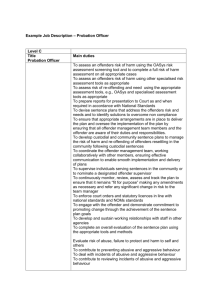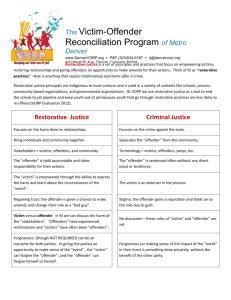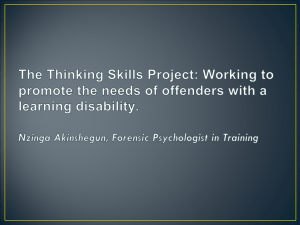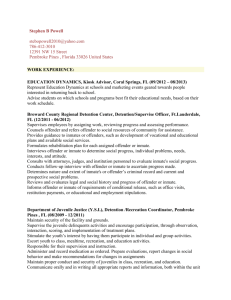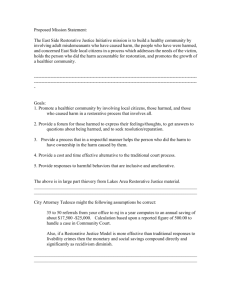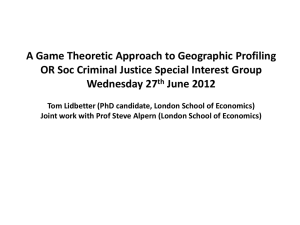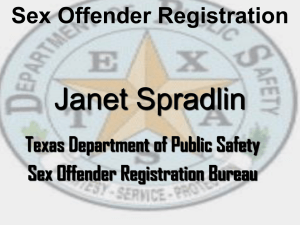DRAFT-ERJ-general pr..
advertisement
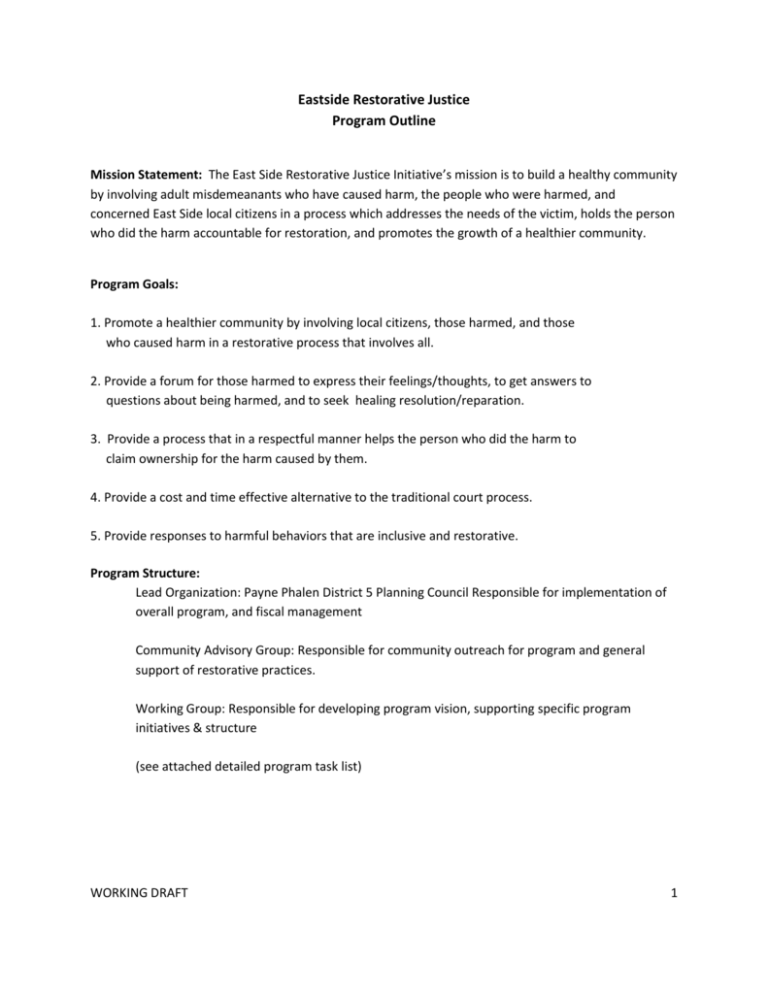
Eastside Restorative Justice Program Outline Mission Statement: The East Side Restorative Justice Initiative’s mission is to build a healthy community by involving adult misdemeanants who have caused harm, the people who were harmed, and concerned East Side local citizens in a process which addresses the needs of the victim, holds the person who did the harm accountable for restoration, and promotes the growth of a healthier community. Program Goals: 1. Promote a healthier community by involving local citizens, those harmed, and those who caused harm in a restorative process that involves all. 2. Provide a forum for those harmed to express their feelings/thoughts, to get answers to questions about being harmed, and to seek healing resolution/reparation. 3. Provide a process that in a respectful manner helps the person who did the harm to claim ownership for the harm caused by them. 4. Provide a cost and time effective alternative to the traditional court process. 5. Provide responses to harmful behaviors that are inclusive and restorative. Program Structure: Lead Organization: Payne Phalen District 5 Planning Council Responsible for implementation of overall program, and fiscal management Community Advisory Group: Responsible for community outreach for program and general support of restorative practices. Working Group: Responsible for developing program vision, supporting specific program initiatives & structure (see attached detailed program task list) WORKING DRAFT 1 PAYNE PHALEN DISTRICT 5 PLANNING COUNCIL WORKING GROUP COMMUNITY ADVISORY GROUP Program Model The program will utilize a community conferencing model. Community Conferencing is one form of Restorative Justice. It brings victims, offenders, and community members together to resolve specific incidents of crime or conflict. The conference begins with a discussion about the impact of the offense, which gives a voice to the community and educates the offender as to the impact of their offense. The conference ends with an agreement to repair the harm that both the offender and victims agree to, which typically includes community service, and may involve apologies, donations, or personal development of the offender. Case Selection/Flow Chart: The city attorney and police will recommend potential cases to the program. (See the attached flow chart) Offenses Included The conferences will focus on adult nuisance behaviors that affect the quality of life of the community. This may include public drinking, public urination, loitering, prostitution solicitation, graffiti, disorderly houses, etc. Service Area The conferences will be held in the Payne Phalen District 5 and Dayton’s Bluff District 4 communities. The city attorney has the discretion to include additional cases as needed. Case Preparation: Each offender will have their case referred by either the police or the city attorney. The offender will receive a full explanation of the program including the process, the cost, the timeline, and community expectations of the process from staff. The offender will complete an application to the program. If the offender agrees to proceed with the process, then staff will review the case and take the necessary steps to set-up a conference including location, notification of victims, offender, and facilitators. The staff will be responsible for providing the facilitators the necessary information for the conference. WORKING DRAFT 2 Frequency of Conferences: Conferences will be held at least monthly with the possibility of one per neighborhood if enough cases are ready for conferencing. Conference Process: Orientation: Each conference will start with a brief orientation for the offenders and volunteers. The orientation will include an explanation of the process, program evaluation, and offenders will have the opportunity to review some suggested restoration plans. Conference: Each conference will have two facilitators. They will start the conferences with introductions and an outline of how the conference process will work and ground rules. The offender and victims will have an opportunity to discuss the offense and its impact. Restoration Plan: The offender will suggest a restoration plan. The group will discuss the suggested plan and from there develop a plan that everyone can agree to, along with a timeline for completion. The offender will sign off on the accepted plan. Conference Conclusion: The facilitators will thank everyone for their participation and ask everyone to fill out a brief evaluation. Case Follow-Up: Staff/volunteers will be responsible for following up with an offender as their timeline for completion ends. If the offender has completed their plan in the time allowed the staff/volunteer will inform the city attorney. If the offender does not successfully complete their plan, then the city attorney will be informed and the offender will be charged thru the court system. Volunteer Opportunities Conference Concerned Citizen-As a conference community member you would participate in conferences being held by assisting in communicating the impact of their crime on the community and in developing the offender’s plan to repair the harm. This position will require a brief program orientation prior to participating. Facilitator- As facilitator you would co-lead the group conference. Each conference has two moderators that work together to lead the discussions, develop the plans, and reach consensus. This volunteer position requires about 20 hours of training, and 3-4 hours per conference with case preparation. Partner Organizations serve a valuable role. They may provide space for conferences, donations, or act as an agency where an offender can complete their community service. Volunteer/Partner Management: All volunteers and partner organization will complete volunteer applications. Staff will be responsible for ensuring volunteers that require training/program orientation receive the required information/training prior to participating in the program. Staff will be responsible for scheduling volunteers as needed. Staff will maintain a database of partner organization that is updated on a regular basis. WORKING DRAFT 3 Program Evaluation: Program evaluation will take place at several points in the process. Offenders will fill out evaluations after the conference they participate in and again about the overall program at the end of their completion of their restoration plan. Concerned neighbors will fill out evaluations after each conference they participate in. Partner organizations will be asked to complete a yearly evaluation. The workgroup will also conduct a yearly program review taking the various evaluations completed throughout the year into consideration. WORKING DRAFT 4
